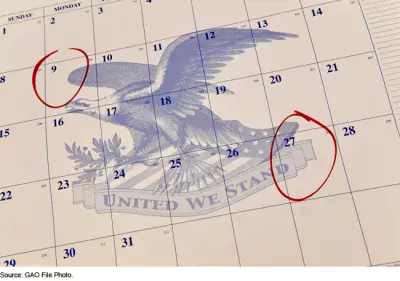How do Federal Agencies Monitor Employee Time and Attendance in In-Person and Remote Settings?
The coronavirus pandemic caused many workers in the U.S. to shorten their commute from city to couch. This change also affected the federal workforce, which—during 2020 and 2021—teleworked more than ever. But even when federal workers were required to show up to their offices, how did agencies check to make sure they worked the time they claimed?
Today’s WatchBlog post looks at our work on telework during the pandemic, and how federal agencies monitor employees’ time and attendance—whether they are in office or at home.
Image

Teleworking during the pandemic
During the pandemic, federal agencies used telework as a strategy to help continue work while office closures and physical distancing measures were in place. In November 2020, we testified before members of Congress about key practices to help ensure the success of agencies’ telework programs—including, among others, providing the technology and training to employees needed to telework successfully.
What has been the extent of the federal government’s use of telework during the pandemic? We’ve got ongoing work about this, including about the challenges agencies faced with telework during the pandemic and considerations for the future. But, in the meantime, let’s take a look at how federal agencies check to make sure employees are working when they say they are.
Checking employees’ time and attendance
In August 2020, we reported that agencies had time and attendance policies, procedures, and controls in place prior to the pandemic.
In this report we looked at how 24 large agencies checked that employees were showing up for work (attendance) and working the hours they said they had (time). We found that—between FY 2015 and 2019—the inspectors general from 19 of the 24 agencies we reviewed had reported only 5 or fewer substantiated allegations of time and attendance misconduct at their agencies. (Inspectors general are independent investigators within government agencies.) Data collection largely preceded any contingency operations activated in response to COVID-19 and therefore reflects normal agency operations.
How are time and attendance inconsistencies identified?
Agencies in our review said when employee time and attendance concerns arise, they are usually reported by other employees. For example, managers such as first-line supervisors can report if they think an employee is abusing time and attendance requirements.
When federal agencies receive concerns, they can use systems like badge-in and badge-out data, video surveillance, network login information, and government-issued routers to check if misconduct occurred. However, agency officials told us that this technology does not prevent misconduct, if an employee is intent on circumventing worktime rules.
Most agencies we reviewed reported that they did not determine that any specific work conditions (including telework), job categories, or pay or leave categories were at higher risk of time and attendance fraud. And most agencies said that the risk of fraud was generally low.
Automation is increasing but managers are the most important internal control
Timekeeping systems are increasingly automated, allowing agencies to implement specific internal controls that may provide management with the confidence that the system is working as designed. For example, separating duties for validating and certifying a timecard within an agency’s timekeeping system ensures that someone else needs to check each employee’s timecard. While these internal controls are designed to prevent errors, agencies provided examples of how these internal controls and technology can also be used to prevent and detect time and attendance misconduct. For example, one agency used a data analytics tool to monitor time and attendance reporting to look for outliers that might warrant additional investigation. Another agency said it runs reports on employees who hold significant advance leave balances since this can indicate future time and attendance problems.
Agencies noted that a first-line supervisor’s management is still the most important internal control for managing time and attendance.
- Comments on GAO’s WatchBlog? Contact blog@gao.gov.
GAO Contacts
Related Products

GAO's mission is to provide Congress with fact-based, nonpartisan information that can help improve federal government performance and ensure accountability for the benefit of the American people. GAO launched its WatchBlog in January, 2014, as part of its continuing effort to reach its audiences—Congress and the American people—where they are currently looking for information.
The blog format allows GAO to provide a little more context about its work than it can offer on its other social media platforms. Posts will tie GAO work to current events and the news; show how GAO’s work is affecting agencies or legislation; highlight reports, testimonies, and issue areas where GAO does work; and provide information about GAO itself, among other things.
Please send any feedback on GAO's WatchBlog to blog@gao.gov.




